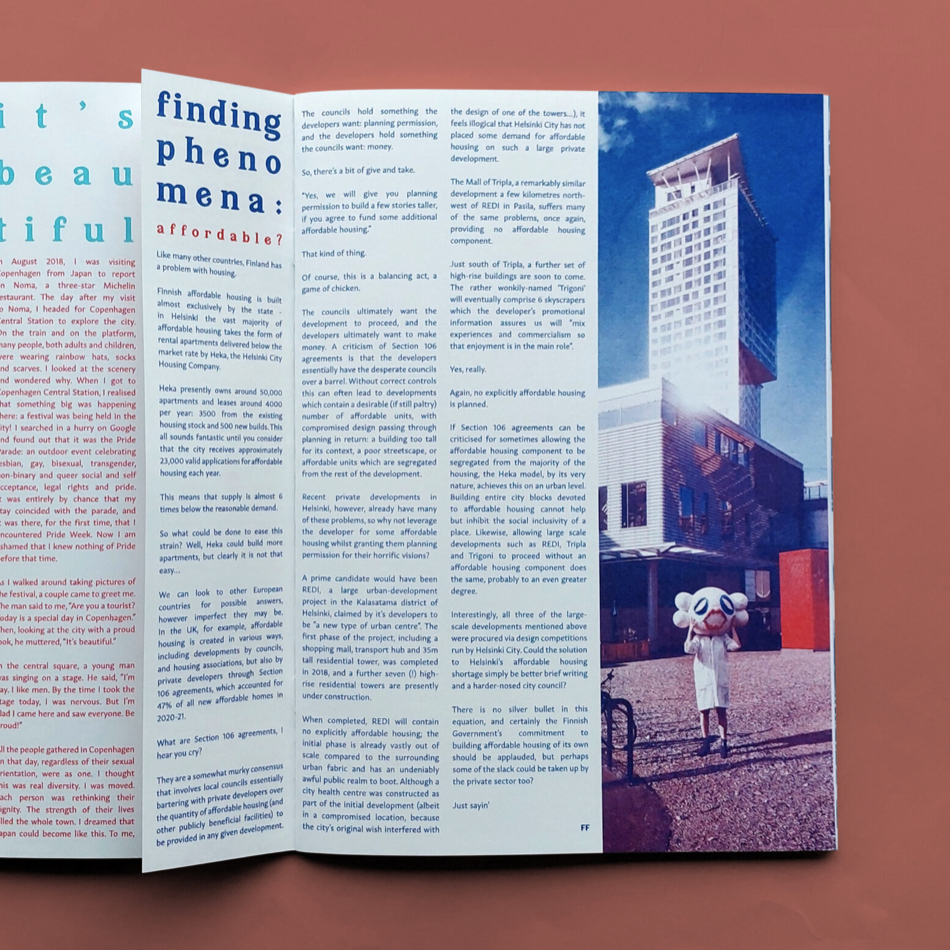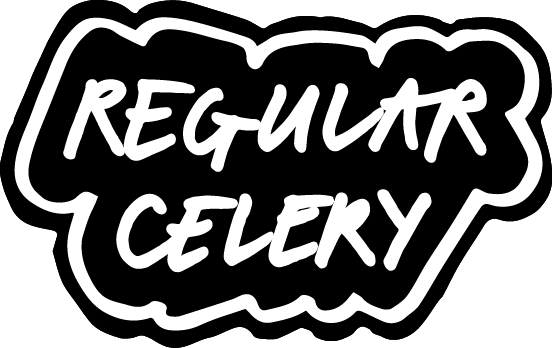Finding Phenomena: Affordable?
Originally published in BUM Edition 5: Enough under the name Franny Françoise.

Like many other countries, Finland has a problem with housing.
Finnish affordable housing is built almost exclusively by the state and in Helsinki the vast majority of affordable housing takes the form of rental apartments delivered below the market rate by Heka, the Helsinki City Housing Company. Heka presently owns around 50,000 apartments and leases around 4000 per year, 3500 from the existing housing stock, and 500 new builds. This all sounds fantastic until you consider that the city receives approximately 23,000 valid applications for affordable housing each year.
This means that supply is almost 6 times below the reasonable demand.
So what could be done to ease this strain? Well, Heka could build more apartments, but clearly it is not that easy…
We can look to other European countries for possible answers, however imperfect they may be. In the UK, for example, affordable housing is created in various ways, including developments by councils, and housing associations, but also by private developers through Section 106 agreements, which accounted for 47% of all new affordable homes in 2020-21.
What are Section 106 agreements, I hear you cry? They are a somewhat murky consensus that involves local councils essentially bartering with private developers over the quantity of affordable housing (and other publicly beneficial facilities) to be provided in any given development. The councils hold something the developers want: planning permission, and the developers hold something the councils want: money.
So, there’s a bit of give and take.
“Yes, we will give you planning permission to build a few stories taller, if you agree to fund some additional affordable housing.”
That kind of thing.
Of course, this is a balancing act, a game of chicken. The councils ultimately want the development to proceed, and the developers ultimately want to make money. A criticism of Section 106 agreements is that the developers essentially have the desperate councils over a barrel. Without correct controls this can often lead to developments which contain a desirable (if still paltry) number of affordable units, with compromised design passing through planning in return: a building too tall for its context; a poor streetscape; or affordable units which are segregated from the rest of the development.
Recent private developments in Helsinki, however, already have many of these problems, so why not leverage the developer for some affordable housing whilst giving them planning permission for their horrific visions? A prime candidate would have been REDI, a recent development which contains a shopping mall and eight (!) residential towers, of which one, standing 35m tall, has already been constructed. The completed REDI will contain no explicitly affordable housing, is already vastly out of scale compared to the surround urban fabric, and has an undeniably awful public realm to boot. Although a health centre was constructed as part of the initial development (albeit in a compromised location, because the city’s original wish interfered with the design of one of the towers…), it feels illogical that Helsinki City has not placed some demand for affordable housing on such a large private development.
The Mall of Tripla, a remarkably similar development a few kilometres north-west of REDI, suffers many of the same problems, once again, providing no affordable housing component. Just south of Tripla, a further set of high-rise buildings are soon to come. The rather wonkily-named ‘Trigoni’ will eventually comprise 6 skyscrapers which the developer’s promotional information assures us will “mix experiences and commercialism so that enjoyment is in the main role”. Yes, really. Again, no explicitly affordable housing is planned.
If Section 106 agreements can be criticised for sometimes allowing the affordable housing component to be segregated from the majority of the housing, the Heka model, by its very nature, achieves this on an urban level. Building entire city blocks devoted to affordable housing cannot help but inhibit the social inclusivity of a place. Likewise, allowing large scale developments such as REDI, Tripla and Trigoni to proceed without an affordable housing component does the same, probably to an even greater degree.
Interestingly all three of the large-scale developments mentioned above were procured via design competitions run by Helsinki City. Could the solution to Helsinki’s affordable housing shortage simply be better brief writing and a harder-nosed city council?
There is no silver bullet in this equation, and certainly the Finnish Government’s commitment to building affordable housing of its own should be applauded, but perhaps some of the slack could be taken up by the private sector too? Just sayin’
Like many other countries, Finland has a problem with housing.
Finnish affordable housing is built almost exclusively by the state and in Helsinki the vast majority of affordable housing takes the form of rental apartments delivered below the market rate by Heka, the Helsinki City Housing Company.
Heka presently owns around 50,000 apartments and leases around 4000 per year, 3500 from the existing housing stock, and 500 new builds. This all sounds fantastic until you consider that the city receives approximately 23,000 valid applications for affordable housing each year.
This means that supply is almost 6 times below the reasonable demand.
So what could be done to ease this strain? Well, Heka could build more apartments, but clearly it is not that easy…
We can look to other European countries for possible answers, however imperfect they may be. In the UK, for example, affordable housing is created in various ways, including developments by councils, and housing associations, but also by private developers through Section 106 agreements, which accounted for 47% of all new affordable homes in 2020-21.
What are Section 106 agreements, I hear you cry?
They are a somewhat murky consensus that involves local councils essentially bartering with private developers over the quantity of affordable housing (and other publicly beneficial facilities) to be provided in any given development. The councils hold something the developers want: planning permission, and the developers hold something the councils want: money.
So, there’s a bit of give and take.
“Yes, we will give you planning permission to build a few stories taller, if you agree to fund some additional affordable housing.”
That kind of thing.
Of course, this is a balancing act, a game of chicken.
The councils ultimately want the development to proceed, and the developers ultimately want to make money. A criticism of Section 106 agreements is that the developers essentially have the desperate councils over a barrel. Without correct controls this can often lead to developments which contain a desirable (if still paltry) number of affordable units, with compromised design passing through planning in return: a building too tall for its context, a poor streetscape, or affordable units which are segregated from the rest of the development.
Recent private developments in Helsinki, however, already have many of these problems, so why not leverage the developer for some affordable housing whilst giving them planning permission for their horrific visions?
A prime candidate would have been REDI, a large urban development project in the Kalasatama district of Helsinki. The first phase of the project, including a shopping mall, transport hub and 35m tall residential tower, was completed in 2018, and a further seven (!) high-rise residential towers are presently under construction. When completed, REDI will contain no explicitly affordable housing. The initial phase is already vastly out of scale compared to the surrounding urban fabric and has an undeniably awful public realm to boot. Although a health centre was constructed as part of the initial development (albeit in a compromised location, because the city’s original wish interfered with the design of one of the towers…), it feels illogical that Helsinki City has not placed some demand for affordable housing on such a large private development.
The Mall of Tripla, a remarkably similar development a few kilometres north-west of REDI in Pasila, suffers many of the same problems, once again, providing no affordable housing component.
Just south of Tripla, a further set of high-rise buildings are soon to come. The rather wonkily-named ‘Trigoni’ will eventually comprise 6 skyscrapers which the developer’s promotional information assures us will “mix experiences and commercialism so that enjoyment is in the main role”.
Yes, really.
Again, no explicitly affordable housing is planned.
If Section 106 agreements can be criticised for sometimes allowing the affordable housing component to be segregated from the majority of the housing, the Heka model, by its very nature, achieves this on an urban level. Building entire city blocks devoted to affordable housing cannot help but inhibit the social inclusivity of a place. Likewise, allowing large scale developments such as REDI, Tripla and Trigoni to proceed without an affordable housing component does the same, probably to an even greater degree.
Interestingly, all three of the large-scale developments mentioned above were procured via design competitions run by Helsinki City. Could the solution to Helsinki’s affordable housing shortage simply be better brief writing and a harder-nosed city council?
There is no silver bullet in this equation, and certainly the Finnish Government’s commitment to building affordable housing of its own should be applauded, but perhaps some of the slack could be taken up by the private sector too?
Just sayin’.
